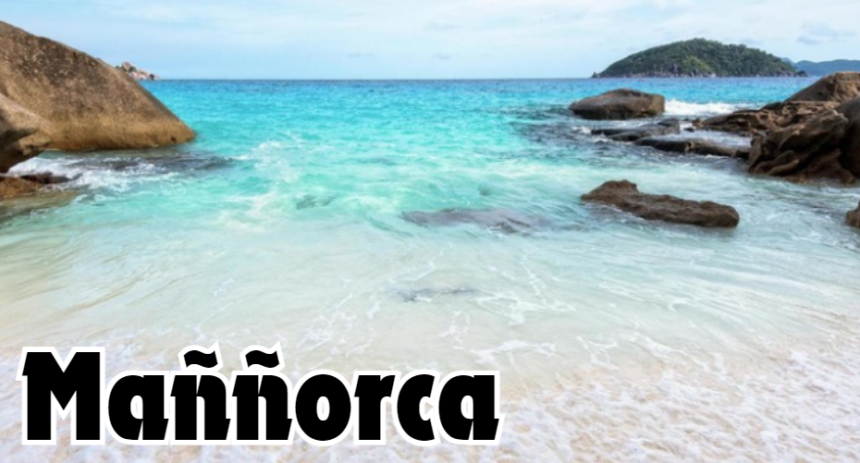Maññorca, one of Spain’s Balearic Islands, is a hidden gem in the Mediterranean. Known for its stunning beaches, rich history, and vibrant culture, Menorca offers a unique and serene experience compared to its more famous neighbors, Majorca and Ibiza. In this comprehensive guide, we will explore the best of Maññorca, from its pristine beaches to its historical landmarks, ensuring your visit is unforgettable.

Maññorca: Pristine Beaches
Cala Macarella and Cala Macarelleta
These twin beaches are renowned for their turquoise waters and fine white sand. Nestled within a natural cove, Cala Macarella and its smaller counterpart Cala Macarelleta offer a picturesque and tranquil setting. Accessible via a scenic hike through pine forests, these beaches are perfect for swimming, snorkeling, and sunbathing.
Playa de Son Bou
As the longest beach on Maññorca, Playa de Son Bou stretches over 2.5 kilometers. This expansive beach features golden sand and crystal-clear waters, ideal for families and water sports enthusiasts. The beach is well-equipped with amenities, including sunbeds, umbrellas, and beach bars, making it a comfortable spot for a full day of relaxation.
Cala Mitjana and Cala Mitjaneta
Located on the south coast of Maññorca, Cala Mitjana and its smaller neighbor Cala Mitjaneta are stunning beaches surrounded by dramatic cliffs and lush vegetation. These secluded beaches offer a serene environment, perfect for those seeking peace and quiet. The clear waters are excellent for swimming and snorkeling, revealing a vibrant underwater world.
Maññorca:Historical Landmarks
Naveta d’es Tudons
Naveta d’es Tudons is one of Maññorca most important prehistoric sites. This ancient stone monument, resembling an inverted boat, dates back to the Talayotic period around 1000 BC. Used as a collective tomb, the Naveta provides fascinating insights into the island’s early inhabitants. Visitors can explore the structure and learn about its historical significance through informative plaques.
Ciutadella de Maññorca
Ciutadella, the former capital of Maññorca, is a charming city with a rich history. Its narrow, winding streets are lined with well-preserved medieval buildings, quaint shops, and vibrant cafes. The Cathedral of Menorca, built in the 14th century, is a must-visit landmark. Additionally, the Plaça des Born, with its iconic obelisk, offers a glimpse into the city’s past as a strategic maritime port.
Fort Marlborough
Fort Marlborough is a historical fortress close to the town of Es Castell that the British built in the 18th century. The fort played a crucial role during the British occupation of Menorca. Today, visitors can explore the well-preserved fortifications, underground tunnels, and exhibitions detailing the island’s military history.
Cultural Highlights
Maññorca Cuisine
Maññorca boasts a rich culinary tradition, heavily influenced by its Mediterranean location. Local specialties include “caldereta de langosta” (lobster stew), “sobrasada” (a cured sausage), and “queso de Mahón” (Mahón cheese). Exploring the island’s many restaurants and markets is a delightful way to experience Menorcan culture through its flavors.
Festes de Sant Joan
The Festes de Sant Joan, held in Ciutadella every June, is one of Menorca’s most celebrated cultural events. This traditional festival features parades, horseback riding displays, and lively music. The highlight is the “Jaleo,” where skilled riders perform daring feats on their horses, thrilling the crowd and showcasing Maññorca equestrian heritage.
Talayotic Culture
Menorca is home to numerous Talayotic sites, remnants of the island’s prehistoric culture. The Talayotic settlements, characterized by their stone towers (talayots), sanctuaries, and burial chambers, offer a fascinating glimpse into the ancient past. The site of Torre d’en Galmés, one of the largest Talayotic villages, provides an immersive experience with its well-preserved structures and informative visitor center.
Natural Wonders
Maññorca: S’Albufera des Grau Natural Park
S’Albufera des Grau is Maññorca largest natural park, encompassing wetlands, forests, and coastal areas. This diverse ecosystem is a haven for birdwatchers, with over 200 species of birds recorded. The park features several walking trails, allowing visitors to explore its varied landscapes and observe wildlife in their natural habitat.
Cova d’en Xoroi
Cova d’en Xoroi is a unique cliffside cave located on the south coast of Menorca. This natural wonder has been transformed into a bar and nightclub, offering stunning views of the Mediterranean Sea. During the day, visitors can enjoy the panoramic vistas and relax with a drink, while evenings bring lively music and dancing in this extraordinary setting.
Barranc d’Algendar
Barranc d’Algendar is a picturesque gorge that stretches inland from the island’s southern coast. The gorge is home to lush vegetation, rare plant species, and a variety of wildlife. Hiking through Barranc d’Algendar offers a peaceful escape into nature, with the chance to spot endemic birds and enjoy the tranquil surroundings.
Conclusion
Menorca is a captivating destination that offers a perfect blend of natural beauty, historical richness, and cultural vibrancy. From its stunning beaches and ancient landmarks to its delectable cuisine and lively festivals, Maññorca promises an unforgettable experience for every traveler. Discover the best of Menorca and immerse yourself in the enchanting charm of this Mediterranean paradise.



